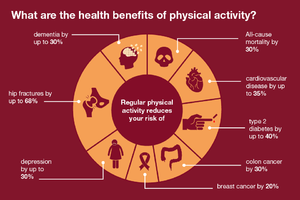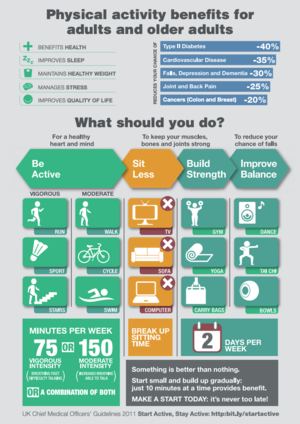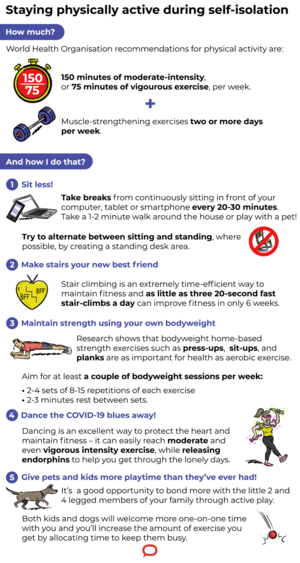Physical Activity and COVID-19
This article or area is currently under construction and may only be partially complete. Please come back soon to see the finished work! (9/05/2020)
Original Editor - Your name will be added here if you created the original content for this page.
Top Contributors - Wanda van Niekerk, Kim Jackson, Vidya Acharya, Lucinda hampton, Laura Ritchie, Oyemi Sillo and Jess Bell
Introduction[edit | edit source]
The COVID-19 pandemic is an unprecedented time all across the world. Worldwide, extensive social distancing policies are put into place, restricting people’s daily activities and worldwide pleas from governments asking people to stay safe and stay at home. This of course means that most people will spend much of their time (if not all) at home.
These social distancing measures mean that people have far fewer opportunities to be physically active, especially if activities such as walking or cycling as transportation means or taking part in a leisurely sports activity (i.e. jogging, walking the dog, going to the gym) are being restricted. Furthermore, these drastic measures also make it so much easier to be sedentary at home for long periods of time.[1] The impact of this physical inactivity may very likely be seen in many areas such as health and social care and the mental well-being of people all across the globe.
Although these social distancing measures are important and needed in a time such as now, our bodies and minds still need physical activity and the many benefits thereof.
Definition of Physical Activity[edit | edit source]
Physical Activity (PA) is defined as any bodily movement produced by skeletal muscles that require energy expenditure.[2] There are two components to Physical Activity that needs to considered:
- Aerobic fitness: this usually includes moderate to vigorous activity that makes you feel a bit warm, causes your breathing to increase and your heart rate to increase.
- Strength and balance: This is often the forgotten component of physical activity, but it is an essential part and has many benefits.
Physical activity may include[3]:
- Active recreation
- Sports participation
- Cycling
- Walking
- Play
- Dance
- Gardening
- House cleaning
- Carrying heavy shopping
During the COVID-19 pandemic it is even more important for all people to be physically active. Even if it is only a short break from sitting at your desk and doing some walking or stretching. Doing something simple as this will[3]:
- ease muscle strain
- relief mental tension
- improve blood circulation
- improve muscle activity
- It also helps to give some routine to a day in these unprecedented times.
Benefits of Physical Activity[edit | edit source]
There are many benefits of physical activity. These include:
- Strengthening and maintaining your immune system strength - being less susceptible to infections[4]
- Reduces high blood pressure
- Weight management
- Reduces the risk of heart disease
- Reduces the risk of diabetes
- Reduces the risk of stroke
- Reduces the risk of certain cancers
- Improves bone and muscle strength
- Improves balance
- Improves flexibility
- Improves fitness
- Improves mental health
- Reduces the risk of depression
- Reduces the risk of cognitive decline
- Delays the onset of dementia
- Improves overall feeling of well-being
- In children physical activity may:
- support healthy growth and development
- reduce the risk of disease in later life
- help in development of fundamental movement skills
Benefits of Strength and Balance Training[edit | edit source]
Often, strength and balance training is forgotten about when thinking of physical activity and many people only focus on the aerobic fitness component and the benefits thereof. These benefits of strength and balance training include:
- Improves blood liquid profile
- Improves vascular function
- Improves immune function
- Builds and maintain muscle mass
- Increases oxidative capacity
- Helps to maintain independence and functional status
- Improves the ageing trajectory
- Improves blood glucose sensitivity
- Improves blood pressure and is a healthy way to manage blood pressure
- Improves body composition - this helps to maintain a healthy weight over time
Despite all these many benefits, physical inactivity costs 5.3 million lives per year globally.[5] It is important therefore to find ways to limit the impact of the COVID-19 pandemic as well as the wider impact it will have on long term chronic diseases.[1]
Physical Activity Guidelines[edit | edit source]
The WHO Guidelines on the amount of physical activity include[6]:
- Infants under the age of 1 year need to be physically active several times a day.
- Children under 5 years of age should spend at least 180 minutes a day in physical activities, with 3-4 year-old's being moderately or vigorously active for an hour a day.
- Children and adolescents aged 5-17 years
- all children and adolescents should do at least 60 minutes a day of moderate to vigorous-intensity physical activity, including activities that strengthen muscle and bone, at least 3 days per week.
- Adults aged over 18 years
- should do a total of at least 150 minutes of moderate-intensity physical activity throughout the week, or at least 75 minutes of vigorous-intensity physical activity throughout the week, including muscle-strengthening activities 2 or more days per week.
- older adults with poor mobility should do physical activity to enhance balance and prevent falls on 3 or more days per week.
Important: Any physical activity is better than none!!!
During the COVID-19 pandemic being physically active will be a challenge for all of us, but it is critical that we find and plan ways to be active and reduce our sedentary time. Although our movement around our neighbourhood, town, city, country and the world might be restricted, it remains critical that we all move more and sit less.
The Importance of Physical Activity during the COVID-19 Pandemic[edit | edit source]
In light of the current situation worldwide, certain benefits of physical activity may be specifically pertinent to the COVID-19 Pandemic. These benefits are:
- Physical activity enhances immune function and reduces inflammation, it could therefore reduce the severity of infections.
- Physical activity improves common chronic conditions that increase the risk for severe COVID-19 (i.e. Cardiovascular Disease, Diabetes).
- Physical activity is a great stress management tool through reducing symptoms of anxiety and depression.
- Physical activity helps bring cortisol levels in balance - Stress and distress (such as during a pandemic) creates an imbalance in cortisol levels and this negatively influences immune function and inflammation.
Physical (In)Activity during "Lock Down"[edit | edit source]
As already iterated, we are living in unprecedented times and we are learning as we go of the effects and impact of this pandemic. With regards to Physical Activity and periods of lock down or restricted regulated movement, there is some evidence emerging, but it is still in the early stages of this pandemic and we won't fully understand the impact of "lock down" for many months.
Insights from data sets[edit | edit source]
Anecdotal evidence[edit | edit source]
Many countries in the world are currently in some or other form of lock down or restricted movement policy and practicing social distancing. Some countries have stricter measures in place with regards to exercise and only allow people to exercise outside/away from their homes once a day or only allow people to exercise outside/away from their homes within a specific time frame or even not allowing any exercise outside/away from home. These restrictions and constraints are specific to each country and the the extent of the COVID-19 outbreak in that specific country. In the media it is publicised that these various measures of lock down may have a positive effect on people's activity levels, with reports of more people being seen outside running, walking, cycling etc. We should be cautious of thinking that this implies that people are now adapting a more active and healthy lifestyle. Physical Activity is accrued over a period of 24 hours in many different ways. Organised or structured sport/exercise is merely a small part of physical activity. Most people accumulate their "active minutes" by doing various other activities such as housework, walking the dog, walking/cycling to and from work, walking between tube/train stations, etc. All these activities are part of people's daily lives and contribute to their physical activity minutes. During periods of lock down, many of these activities are restricted or not even taking place and it is extremely difficult to build in these levels of activity when people's daily movements are restricted.
Wearable Technology[edit | edit source]
Data from wearable technology companies such as Garmin also paints an interesting picture of the type of physical activities people engage in during these times. This data, however, is not really representative or cross sectional,but from people who are using wearable technology such as smartwatches and fitness trackers. Interesting to note is that during the month of March there was a global reduction in the daily average amount of steps taken - which is indicative of people being restricted in their movements. Virtual cycling has increased in countries, such as Italy and Spain with severe lockdown restrictions. In other countries, such as the UK and Sweden, where outdoor exercise is allowed there is a significant increase in outdoor cycling activities, compared to the same time in 2019. People are finding ways to still be active even in extreme lockdown situations, but this data still does not provide a credible idea of a person's cumulative physical activity levels over a 24 hour period.
Early Research Findings[edit | edit source]
University College London launched a social study on the psychological and social experience of people in the UK during the Covid-19 pandemic. During the second week of the study the researchers looked into exercise and social behaviours of over 47 000 participants.This is app-based and self-reported data. Early stage findings from this study include:
- 1 out of 4 people say that they have had no exercise or even gentle physical activity in the past 7 days.
- 85% of study participants reported that they did not engage in any moderate or strenuous exercise at all
- 40% of study participants reported that they had not done any gentle exercise such as going for a walk.
- Even in younger participants (18 - 30 years) four out of five people report not engaging in any moderate or high intensity activity
- People with diagnosed mental and physical health conditions are doing the least physical activity
- Older people are engaging in more gentle activity, but the least in in exercise at home or moderate to strenuous exercise overall
- People living alone are engaging less in all kinds of physical activity
- People from lower income levels are engaging less in all kinds of physical activity
These are early findings and these results will most likely change over time and as lockdown measures eases.
From the various data sets, it is clear that people are finding ways to exercise, but that is not a true reflection of their accrued physical activity over a 24 hour period. Many people also engage in no moderate or strenuous physical activity during lockdown measures - the implications of this will only be evident later on.
Implications of Physical Inactivity during COVID-19[edit | edit source]
Health and Social Care[edit | edit source]
There are a couple of things to consider when looking at the implications of Inactivity during COVID-19 on health and social care:
- It is impossible to predict the outcomes currently
- At best we can try and make educated guesses
- There are global variations to consider such as the time frame around going into lockdown and easing of restrictions in countries as well as differences in health and social systems in countries.
First wave: Population of people who experience COVID-19[edit | edit source]
This population of people who experience COVID-19 and recovery from it will still have ongoing needs. They would have had an enforced period of physical inactivity due to the illness. These people will have specific rehabilitation needs. Currently this is the obvious population of people that receives focus and attentions.
Second wave: People with urgent non-COVID-19 conditions[edit | edit source]
Although, we are dealing with a pandemic at the moment, people all over the world still need healthcare for their existing mental and physical health conditions. Especially during periods of lockdown, this population will still have ongoing needs in terms of self management of their condition. In a scenario where healthcare services and systems are under stress and resources limited it is critical to support people in self-management of their condition. Physical activity and the benefits thereof is one important way of supporting this population of people to self-manage their conditions so that they are able to cope effectively with symptoms such as pain, stiffness, fatigue or breathlessness. As physiotherapists we can play a critical role in supporting people to stay active so that they are healthy enough to self-manage their condition during this time.
Third wave: Impact of interrupted care on chronic conditions[edit | edit source]
During periods of lockdown, routine healthcare services have been put on hold or paused in many countries around the world. Services such as routine screenings, diagnostics and elective surgeries have been put on hold. This will have an impact on this population of people as many people who have thought that there would have been progress in the diagnosis or management of their condition. Even after healthcare services resume for this population, it may still take some time for services to clear the backlog caused by periods of lockdown. This may have far-reaching effects. Again, physiotherapists can make a difference with this population by advocating physical activity as a way to self-manage their conditions.
Fourth wave: Mental health[edit | edit source]
The link between physical activity and mental well-being is clear. Physical activity is a key, critical way to manage mental health well-being and it is important that we as physiotherapists promote this to people, regardless of them having been diagnosed with a mental health condition or not. Studies have reported that enforced sedentary behaviour has led to depressive feelings and low moods in healthy people within seven days. Taking into consideration the current situation worldwide with countries in enforced periods of lockdown and isolation, this may potentially have a mammoth impact on the mental well being of many people!
Ways to Stay Physically Active during COVID-19[edit | edit source]
How to Stay Safe while Exercising during COVID-19[edit | edit source]
Resources[edit | edit source]
- bulleted list
- x
or
- numbered list
- x
References[edit | edit source]
- ↑ 1.0 1.1 https://theconversation.com/how-to-stay-fit-and-active-at-home-during-the-coronavirus-self-isolation-134044
- ↑ World Health Organisation. Physical Activity. Avalaible at: https://www.who.int/dietphysicalactivity/pa/en/ [last accessed 6 April 2020]
- ↑ 3.0 3.1 World Health Organisation. Be Active During COVID-19. Available from https://www.who.int/news-room/q-a-detail/be-active-during-covid-19 [last accessed 6 April 2020]
- ↑ Nieman DC, Henson DA, Austin MD, et al. Upper respiratory tract infection is reduced in physically fit and active adults. British Journal of Sports Medicine 2011;45:987-992.
- ↑ Lee IM, Shiroma EJ, Lobelo F, Puska P, Blair SN, Katzmarzyk PT, Lancet Physical Activity Series Working Group. Effect of physical inactivity on major non-communicable diseases worldwide: an analysis of burden of disease and life expectancy. The Lancet. 2012 Jul 21;380(9838):219-29.
- ↑ World Health Organisation. Physical Activity. Published on 23 February 2018. Available from https://www.who.int/news-room/fact-sheets/detail/physical-activity. (last accessed 8 May 2020).
- ↑ Sallis, JF. Physical activity + COVID-19. Lecture to UC San Diego medical students. March 2020. Published on 1 April 2020. Available from https://www.youtube.com/watch?v=F4mcbi9tD-M. [last accessed 10 April 2020]










